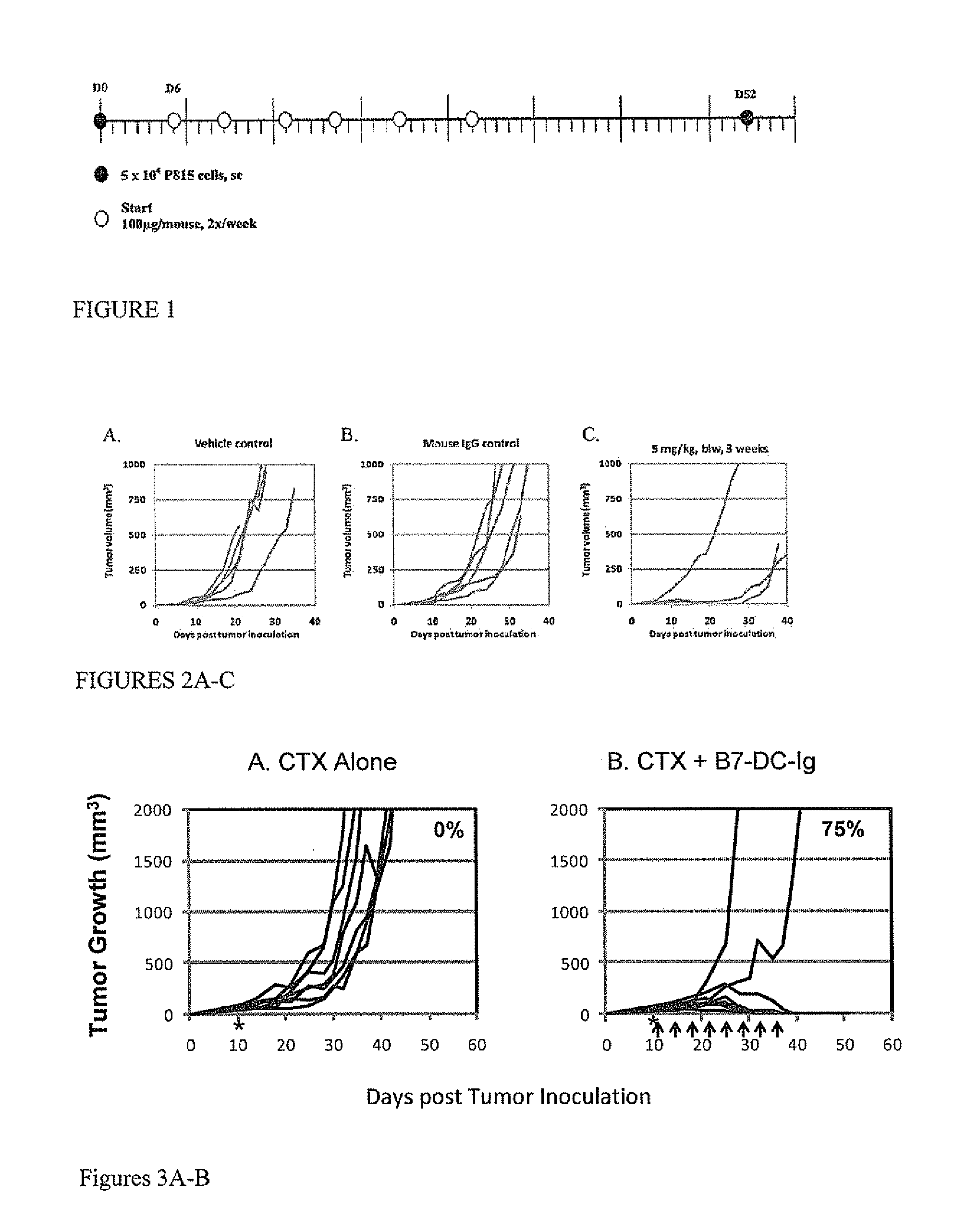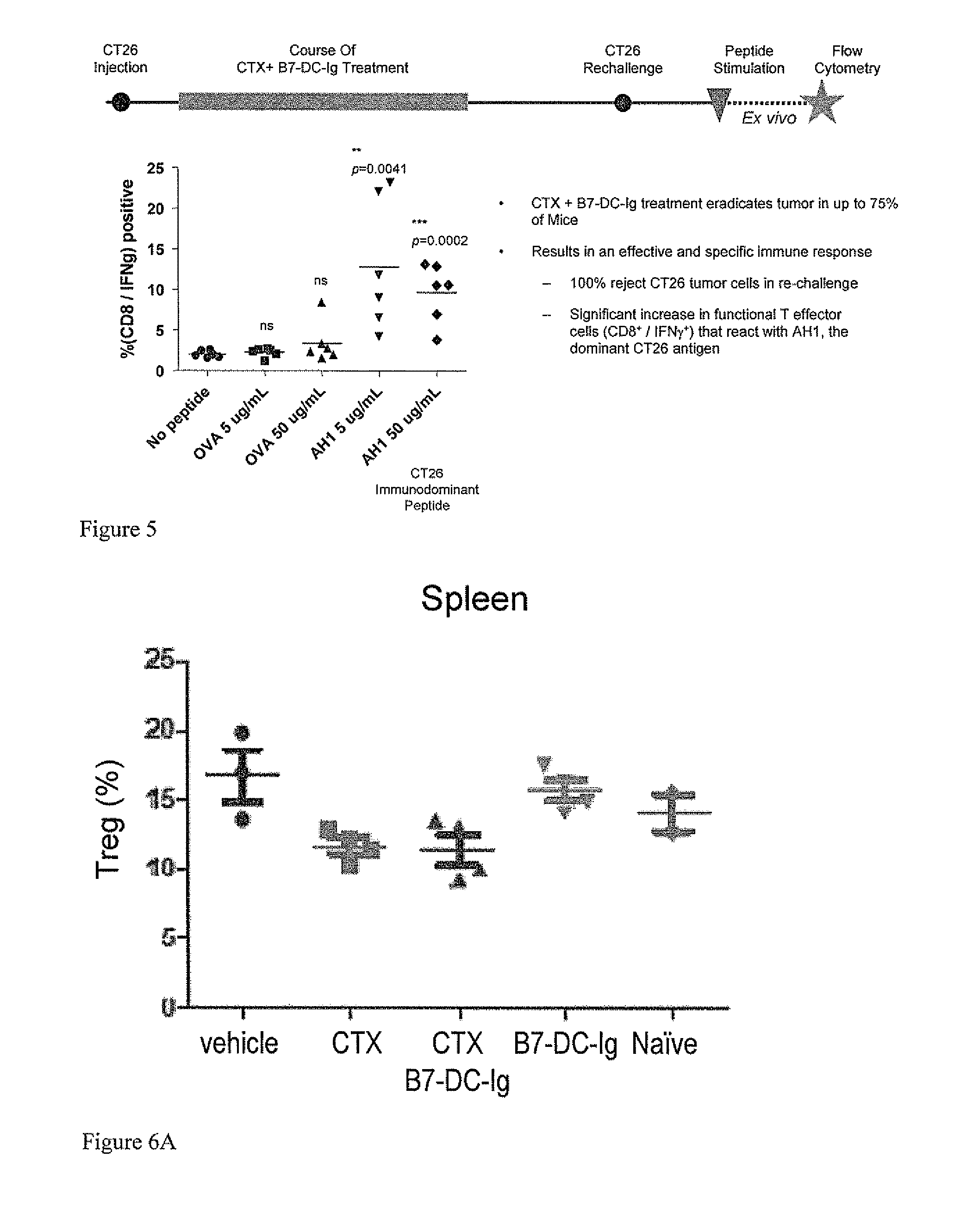Targeted costimulatory polypeptides and methods of use to treat cancer
a costimulatory polypeptide and cancer technology, applied in the direction of peptide/protein ingredients, depsipeptides, dna/rna fragmentation, etc., can solve the problems of inability to reach the effective level of costimulatory molecules in vivo, t cell response of effectors is often weak at best, and large amount of recombinant protein, so as to enhance the function of tumor-infiltrating t cells and enhance the respons
- Summary
- Abstract
- Description
- Claims
- Application Information
AI Technical Summary
Benefits of technology
Problems solved by technology
Method used
Image
Examples
example 1
P815 Mastocytoma Model
[0381]The in vivo activity of murine B7-DC-Ig was tested in the P815 mastocytoma tumor model. P815 mastocytoma cells were derived from DBA / 2 mice after methylcholanthrene (MCA) treatment. Injection of 5×104 cells SC can result in mortality approximately 35 days post tumor inoculation.
[0382]DBA / 2 mice (6-10 weeks of age, females) were first challenged with 5×104 live P815 cells injected SC in the flank. Six days later, the mice were treated with murine B7-DC-Ig via IP injection. The dosing regimen, shown in FIG. 1, was 100 μg of murine B7-DC-Ig per injection (approximately 5 mg / kg), 2 times per week, up to 6 doses. Control groups were treated with vehicle only or with murine IgG. Tumor size was measured with digital calipers every 2-3 days. Mice were euthanized and defined as dead when their tumor size reached or exceeded 1000 mm3, according to protocols approved by the Institutional Animal Care and Use Committee (IACUC) of the American Red Cross (ARC; the site ...
example 2
Combination of Cyclophosphamide and B7-DC-Ig can Eradicate Established Tumors
[0385]Balb / C mice at age of 9 to 11 weeks were implanted subcutaneously with 1.0×105 CT26 colorectal tumor cells. On day 10 post tumor implantation, mice received 100 mg / kg of cyclophosphamide. B7-DC-Ig treatment started 1 day later, on day 11. Mice were treated with 100 ug of B7-DC-Ig, 2 doses per week, for 4 weeks and total 8 doses. 75% of the mice that received the CTX+B7-DC-Ig treatment regimen eradicated the established tumors by Day 44, whereas all mice in the control CTX alone group died as a result of tumor growth or were euthanized because tumors exceeded the sizes approved by IACUC (results shown in FIG. 3). These results demonstrate the effectiveness of the treatment regimen on established tumors and not mere prophylaxis.
example 3
[0386]Combination of Cyclophosphamide and B7-DC-Ig can Eradicate Established Tumors and Protect Against Tumor Re-Challenge
[0387]Mice eradicated established CT26 colorectal tumors from the above described experiment were rechallenged with 1×105 CT26 cells on Day 44 and Day 70. No tumors grew out from the rechallenge suggesting they had developed long term anti-tumor immunity from the cyclophosphamide and B7-DC-Ig combination treatment. All mice in the vehicle control group developed tumors (results shown in FIG. 4). These results show the effectiveness of the treatment regimen on established tumors and that the cyclophosphamide and B7-DCIg combination treatment resulted in memory responses to tumor antigens.
PUM
| Property | Measurement | Unit |
|---|---|---|
| soluble | aaaaa | aaaaa |
| flexible | aaaaa | aaaaa |
| nucleic acid | aaaaa | aaaaa |
Abstract
Description
Claims
Application Information
 Login to View More
Login to View More - R&D
- Intellectual Property
- Life Sciences
- Materials
- Tech Scout
- Unparalleled Data Quality
- Higher Quality Content
- 60% Fewer Hallucinations
Browse by: Latest US Patents, China's latest patents, Technical Efficacy Thesaurus, Application Domain, Technology Topic, Popular Technical Reports.
© 2025 PatSnap. All rights reserved.Legal|Privacy policy|Modern Slavery Act Transparency Statement|Sitemap|About US| Contact US: help@patsnap.com



